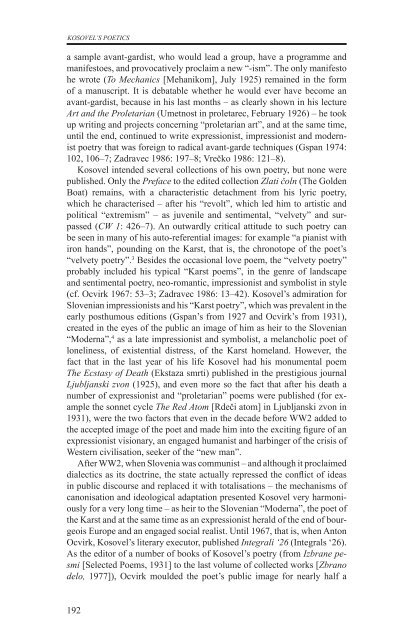razprave (pdf) - Društvo za primerjalno književnost - ZRC SAZU
razprave (pdf) - Društvo za primerjalno književnost - ZRC SAZU
razprave (pdf) - Društvo za primerjalno književnost - ZRC SAZU
- No tags were found...
Create successful ePaper yourself
Turn your PDF publications into a flip-book with our unique Google optimized e-Paper software.
KOSOVEL’s poeticsa sample avant-gardist, who would lead a group, have a programme andmanifestoes, and provocatively proclaim a new “-ism”. The only manifestohe wrote (To Mechanics [Mehanikom], July 1925) remained in the formof a manuscript. It is debatable whether he would ever have become anavant-gardist, because in his last months – as clearly shown in his lectureArt and the Proletarian (Umetnost in proletarec, February 1926) – he tookup writing and projects concerning “proletarian art”, and at the same time,until the end, continued to write expressionist, impressionist and modernistpoetry that was foreign to radical avant-garde techniques (Gspan 1974:102, 106–7; Zadravec 1986: 197–8; Vrečko 1986: 121–8).Kosovel intended several collections of his own poetry, but none werepublished. Only the Preface to the edited collection Zlati čoln (The GoldenBoat) remains, with a characteristic detachment from his lyric poetry,which he characterised – after his “revolt”, which led him to artistic andpolitical “extremism” – as juvenile and sentimental, “velvety” and surpassed(CW 1: 426–7). An outwardly critical attitude to such poetry canbe seen in many of his auto-referential images: for example “a pianist withiron hands”, pounding on the Karst, that is, the chronotope of the poet’s“velvety poetry”. 3 Besides the occasional love poem, the “velvety poetry”probably included his typical “Karst poems”, in the genre of landscapeand sentimental poetry, neo-romantic, impressionist and symbolist in style(cf. Ocvirk 1967: 53–3; Zadravec 1986: 13–42). Kosovel’s admiration forSlovenian impressionists and his “Karst poetry”, which was prevalent in theearly posthumous editions (Gspan’s from 1927 and Ocvirk’s from 1931),created in the eyes of the public an image of him as heir to the Slovenian“Moderna”, 4 as a late impressionist and symbolist, a melancholic poet ofloneliness, of existential distress, of the Karst homeland. However, thefact that in the last year of his life Kosovel had his monumental poemThe Ecstasy of Death (Eksta<strong>za</strong> smrti) published in the prestigious journalLjubljanski zvon (1925), and even more so the fact that after his death anumber of expressionist and “proletarian” poems were published (for examplethe sonnet cycle The Red Atom [Rdeči atom] in Ljubljanski zvon in1931), were the two factors that even in the decade before WW2 added tothe accepted image of the poet and made him into the exciting figure of anexpressionist visionary, an engaged humanist and harbinger of the crisis ofWestern civilisation, seeker of the “new man”.After WW2, when Slovenia was communist – and although it proclaimeddialectics as its doctrine, the state actually repressed the conflict of ideasin public discourse and replaced it with totalisations – the mechanisms ofcanonisation and ideological adaptation presented Kosovel very harmoniouslyfor a very long time – as heir to the Slovenian “Moderna”, the poet ofthe Karst and at the same time as an expressionist herald of the end of bourgeoisEurope and an engaged social realist. Until 1967, that is, when AntonOcvirk, Kosovel’s literary executor, published Integrali ‘26 (Integrals ‘26).As the editor of a number of books of Kosovel’s poetry (from Izbrane pesmi[Selected Poems, 1931] to the last volume of collected works [Zbranodelo, 1977]), Ocvirk moulded the poet’s public image for nearly half a192
















